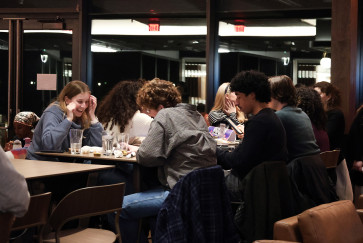With undergraduate classes beginning today, Northwestern welcomes more than 2,100 new first-year students as members of the Class of 2028, as well as more than 250 transfer students.
The first-year students in this class are from around the world — all 50 states and Puerto Rico, 90 different countries (Togo among them for the first time) and six continents. Approximately 13% of the class are international citizens — a University record. Across the cohort, students speak more than 90 different languages.
The Class of 2028 includes students from more than 1,400 high schools around the world, according to preliminary numbers from the first day of class. Their socioeconomic diversity is in part reflected in a Pell-eligible population comprising nearly 22% of the class — a record number of lower-income students at Northwestern. This year’s incoming cohort also brings strong representation across other historically underrepresented populations: Black or African American at 15.4%, Hispanic or Latinx/e at 17.5%, Native or Indigenous at 2.4%, and first-generation college student at 16%.
Late last night, U.S. News & World Report released its 2025 Best Colleges rankings, ranking Northwestern #6 in the National Universities category, its highest ranking ever. President Michael Schill said part of what makes Northwestern such a great place to learn is having a diverse student body, through which students are exposed to different viewpoints.
“Our commitments to expansive outreach, innovative and student-centered recruitment practices, holistic admissions review and widening college access reflect Northwestern’s values,” Schill said. “Now we get to see those values bear out in this remarkable new class, and in the new rankings.
“Thanks to the leadership of the enrollment team and collaboration across campus, we have an exceptional group of students joining our community this year, and we’re so excited to welcome them as they begin this step in their educational journeys.”
Continuing the commitment to diversity, inclusion and belonging
Before the U.S. Supreme Court decision in June 2023 that ended race-conscious admissions at colleges and universities, a working group convened by Provost Kathleen Hagerty had already begun to assess existing practices, and to consider new strategies to ensure the University adheres to federal law while continuing to support diversity, inclusion and belonging on its three campuses.
In alignment with federal guidance, the working group continued to meet as schools and units carried out revised admissions practices.
“Although the Supreme Court decision impacts the use of race in admissions, it does not affect the University’s ability to define our mission and values, including the importance of diversity and inclusion,” said Stacey Kostell, vice president and dean of enrollment. “Our holistic admissions process is built to account for the diversity of experiences, circumstances and backgrounds reflected across our applicant pool.”
“The decision also left open avenues for pursuing outreach and recruitment to advance these values,” she continued, “and as President Schill stressed last spring, we are intensifying strategic efforts that have helped us enroll historically diverse classes in recent years. That includes financial aid packages that meet 100% of every student’s demonstrated need without loans, as well as initiatives to ensure families understand our full range of affordability measures and student-support resources.”



